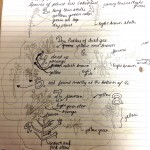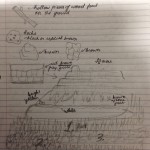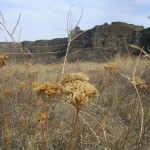Field Notes:
1st Location: Dry Falls Lake
October 12th, 2012
Late morning
Weather/Atmosphere:
Mostly sunny
Warm with slight breeze
Overall composition:
Rocks, grass, shrubs, trees
Buttes, basins, lakes, boulders
Beetles, centipedes, birds, snakes
Old persons fishing
Us, observers
Deer, deer tracks, deer scat, coyote scat
Pebbles, crumbles, dust, rocks, ‘ball-bearings’, rock piles, rock hills, rock terrain
Sounds:
Ducks, geese, small birds, crows
Bees, flies
Highway 17
Boat motors
Occasional fishermen’s conversations
Observations on rocks:
Mostly different shades of brown
Lines of light red or dark pink
Sections of white or grey rock among the mostly rusty brown surface
Perfect habitat in the high peaks for birds, though too unstable for humans.
Sections of green, lichen
All the rocks have some degree of growth on them. Dry lichen or moss spreads over everything despite maintaining a reserved presence once established.
Five layers: 3 layers are right angled, fourth layer is sloped and slanted, a very thin strip of white rocks at the bottom
Generally rough edged, not smooth
Observations on soil:
Soil looks clumpy and grainy
A thick clay and sand mixture near the water
The clay-dirt soil is difficult to distinguish from crumbled basalt and it appears inevitable that the two are in a constant state of change: rocks to dust, mixing with the red, dry soil. When the soil is rubbed between to fingers it has the consistency of flour – a fine, powdery substance.
Generally shades of light brown to dark rusty brown
Twigs and branches
Barely see actual dirt and soil in the areas closer to the rock formation, mostly gravel
Observations on lake:
Cold
Dark green, gray, very reflective
The white of the rocks once below the water, shows 2 things: *the water is basic *the water is significantly low, a dry season
Thicker brush and taller grasses around the water means more nutrients around the lake
Culture:
On the top of the cliff in the distance I see cars, contrails, power lines and buildings. Next to them I see trees of different varieties (Poplar) than are found anywhere in the nature of the Dry Falls landscape. Possibly a cultural influence.
Most cultural of the 3 locations
Other notes:
Most promenant color theme is yellow to golden brown
Not flat or open ground, high and low elevations
Grasses grow in most places, among the sage, between rocks, and, of course, over the great flat expanses . . .
A lot of geographic variation in a small area: some spots are cliff face to water, some are grass to swamp to water, some are cliff face to talus to water
Recognizing lots of geographical features we learned about on many scales, mostly miniature (weather or not they were formed by the same processes)
There are many dead trees and bushes
Some areas look very dried up
Found a praying mantis, Mantis religiosa (in Native American beliefs they are a symbol of stillness)
Blue Grama grass, Bouteloua gracilis
Found a pile, scattered across 5 feet, of clustered exoskeleton and fish bones. Looked as though it could have been a feeding area for water birds, possibly herons since they feed socially.
The plants growing on the rocky areas look dry, unhealthy
Most life/culture of the 3 locations, present life as well as signs of life
Repetitive shape and forms are clusters and clumps, like the rocks, feces, bones and concentration of people
Most blossoms are yellow, seasonal?
Butterflies: Algais milberti, or Milbert’s Tortoiseshell Butterfly (common in all of western United States, feeds on thistle, is a sign of a wet area)




